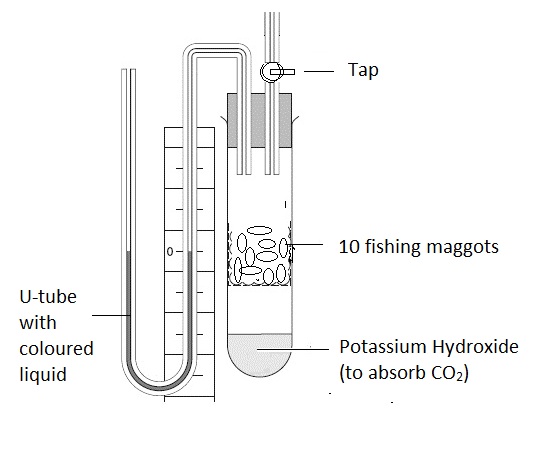Respiration experiments.
 Investigations of respiration in yeast and maggots.
Investigations of respiration in yeast and maggots.
Two nice experiments, the first looks a respiration rates in fly larvae and the second links the structures of different carbohydrates to the rate of respiration in yeast. This is an opportunity to discuss the ethical use of animals in experiments, an important part of planning for the IA investigation.
Lesson Description
Guiding Question
As respiration is controlled by enzymes, does temperature affect the rate the same as it would affect enzymes?
What other factors could affect the rate of respiration?
Activity 1 - Respirometer Experiment with Blowfly Maggots
Carry out the Experiment using the instructions on the ![]() Respirometer experiment - maggots worksheet below. Respirometers take some time to set up and test that they are leak-free. Once they are working, precise data can be collected quickly.
Respirometer experiment - maggots worksheet below. Respirometers take some time to set up and test that they are leak-free. Once they are working, precise data can be collected quickly.
Activity 2 - Experiment on Yeast Respiration with different substrates
Alternatively this experiment ![]() Yeast respiration - different substrates is guaranteed to provide results, although the data are not quite so precise.
Yeast respiration - different substrates is guaranteed to provide results, although the data are not quite so precise.
Carry out the Experiment using the instructions on the worksheet below.
Teachers notes
Depending on the time available and the need for IA work, students could do one or both of these experiments. One of the advantages of this topic is that there is a lot of potential for practical work.
The maggot respirometer experiment takes longer to complete, especially if students set up the respirometer themselves. The yeast experiment is simpler to carry out and quicker, so long as the class pools their data. The limit is often the availability of measuring cylinders, but boiling tubes would also work.
Of course there are many ways to do both of these experiments depending on the students and the equipment available. The techniques are useful for students to experience before they design their own experiments.
Thinking through modifications of the method and improvements in the apparatus with a class is a good way to model the planning process.

 IB Docs (2) Team
IB Docs (2) Team
